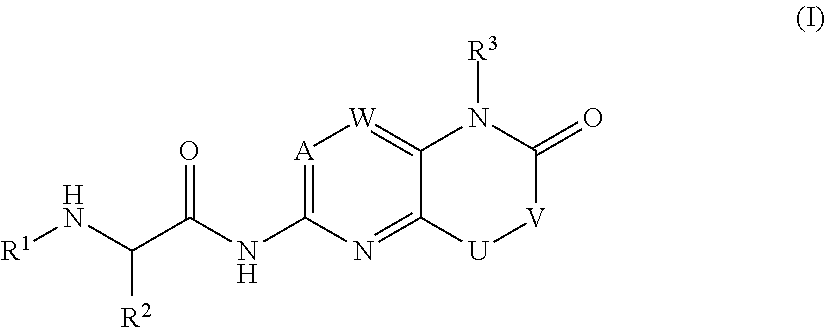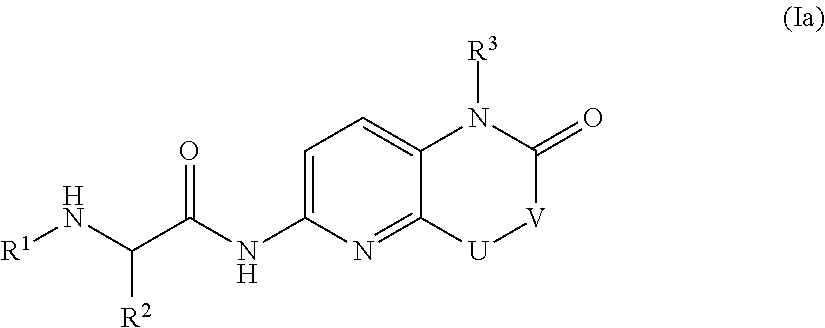Bicyclic heterocycle compounds and their uses in therapy
a technology of bicyclic heterocycle compounds and therapeutic applications, applied in the field of new bicyclic compounds, can solve problems such as poor clinical outcomes, and achieve the effects of halting the progress rate, improving the condition, and reducing the progress ra
- Summary
- Abstract
- Description
- Claims
- Application Information
AI Technical Summary
Benefits of technology
Problems solved by technology
Method used
Image
Examples
example 1
N-[3-(4-Chloro-benzyl)-2-oxo-2,3-dihydro-1H-imidazo[4,5-b]pyridin-5-yl]-2-methylamino-propionamide hydrochloride (prepared as a mixture of enantiomers)
[0657]
[0658]Step 1:
[0659]4-Chlorobenzylamine (7.3 mL, 60 mmol) was added dropwise to a stirred, cooled (˜0° C.), solution of 2,6-dichloro-3-nitropyridine (10.1 g, 52.2 mmol) and K2CO3 (7.93 g, 57.4 mmol) in MeCN (60 mL). After stirring for 5 hours at ambient temperature, the mixture was concentrated in vacuo and then partitioned between EtOAc and water. The EtOAc layer was then washed successively with aqueous potassium hydrogen sulfate solution, brine and then dried (MgSO4). The solution was evaporated in vacuo to give a yellow solid which was recrystallised from heptane / EtOAc (1:2) to give (4-chloro-benzyl)-(6-chloro-3-nitro-pyridin-2-yl)-amine as a yellow solid (7.67 g). The mother liquor was evaporated and the residue recrystallised from EtOH to give a second crop of product (3.39 g). MS: [M+H]+=298
[0660]Step 2:
[0661](4-Chloro-ben...
example 2
(S)—N-[1-(4-Chloro-phenyl)-2-oxo-2,3-dihydro-1H-pyrido[2,3-b][1,4]oxazin-6-yl]-2-methylamino-propionamide hydrochloride
[0668]
[0669]Step 1:
[0670]A stirred solution of 2,6-dichloro-3-nitropyridine (15 g, 78 mmol) and ethyl glycolate (8.1 mL, 86 mmol) in 1,4-dioxane (150 mL) was cooled to 10° C. NaH (60% dispersion in oil) (3.42 g, 86 mmol) was added batchwise. The mixture was then allowed to stir for 6 hours at ambient temperature. The mixture was then cooled (˜10° C.) and treated with saturated aqueous ammonium chloride solution. Water was added until all the solid had dissolved and the mixture was extracted with EtOAc. The EtOAc layer was washed with brine, dried over
[0671]MgSO4, filtered and concentrated in vacuo. The residue was purified by crystallisation from EtOH (80 mL) to give (6-chloro-3-nitro-pyridin-2-yloxy)-acetic acid ethyl ester (8.55 g). [M+H]+ 261
[0672]Step 2:
[0673]To a cooled (˜10° C.) solution of (6-chloro-3-nitro-pyridin-2-yloxy)-acetic acid ethyl ester (8.0 g, 30....
example 3
(S)—N—[(S)-1-(4-Chloro-phenyl)-3-methyl-2-oxo-3-phenyl-2,3-dihydro-1H-pyrido[2,3-b][1,4]oxazin-6-yl]-2-methylamino-propionamide hydrochloride
[0682]1H NMR (DMSO-d6) 1H NMR 11.17 (1H, br), 9.01 (2H, br), 7.67 (2H, d), 7.58 (1H, d), 7.53-7.30 (7H, m), 6.80 (1H, d), 3.98-3.92 (1H, m), 2.54 (3H, s), 1.90 (3H, s), 1.46 (3H, d). [M+H]+ 451.
[0683]Starting with (S)-(+)-2-hydroxy-2-phenylpropionic acid methyl ester and 2,6-dichloro-3-nitropyridine, the title compound was prepared by using similar methods to those described for Example 2 (Steps 1-7) with the exception of Step 3, which was performed using Fe / AcOH rather than Pd / C-hydrogen; as follows.
[0684]To (S)-2-[6-(2,4-dimethoxy-benzylamino)-3-nitro-pyridin-2-yloxy]-2-phenyl-propionic acid methyl ester (253 mg, 0.54 mmol) in AcOH (7 mL) was added Fe-powder (242 mg, 4.32 mmol). The mixture was heated at 60° C. for 3 hours and then allowed to cool. The mixture was evaporated in vacuo and then the residue was purified using SiO2 chromatography...
PUM
 Login to View More
Login to View More Abstract
Description
Claims
Application Information
 Login to View More
Login to View More - R&D
- Intellectual Property
- Life Sciences
- Materials
- Tech Scout
- Unparalleled Data Quality
- Higher Quality Content
- 60% Fewer Hallucinations
Browse by: Latest US Patents, China's latest patents, Technical Efficacy Thesaurus, Application Domain, Technology Topic, Popular Technical Reports.
© 2025 PatSnap. All rights reserved.Legal|Privacy policy|Modern Slavery Act Transparency Statement|Sitemap|About US| Contact US: help@patsnap.com



